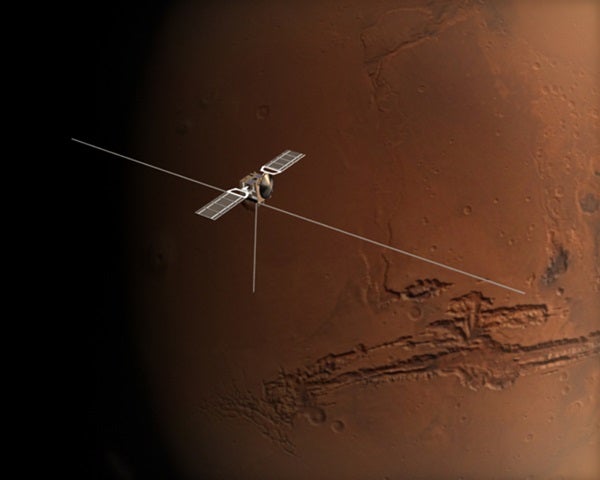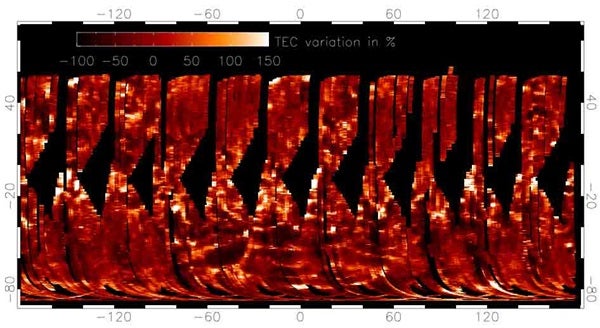Although Mars is sometimes described as the most Earth-like of all the planets, there are many differences between the two worlds that scientists are trying to understand. One of the less familiar aspects of both planets is that they possess an ionosphere — a layer of ionized (electrically charged) particles — in their upper atmospheres.
Earth’s ionosphere has been studied intensively and is invaluable as a reflector of radio waves, but until recently, little was known about the Martian ionosphere.
Previous measurements indicated that Mars’ ionosphere generally lies about 110 to 130 km above the planet. In this region, high-energy solar radiation and particles in the solar wind split the atoms and molecules in the upper atmosphere, releasing free electrons. One of the most surprising results from Mars Express has been the discovery of an ionosphere above the planet’s hemisphere, which is in the dark.
Some of the most exciting results are being sent back by the MARSIS (Mars Advanced Radar for Subsurface and Ionospheric Sounding) experiment by low frequency radio waves towards the planet’s surface, which record the echoes of the different layers.
Although the main task of MARSIS is to probe beneath the planet’s surface in search of unseen geological materials and structures, the radar is also a valuable tool for learning about the ionosphere. This is because the radio waves from MARSIS are reflected and modified as they pass through the ionized layer.
Now, after some two years of operation, an international team of scientists has been able to analyze more than 750,000 echoes from MARSIS in order to make the first direct measurement of the global distribution of electrons in the Martian ionosphere, or the total electron content (TEC).
The received echoes are weakened, delayed and dispersed, depending on the electron density in the ionosphere directly below the spacecraft. In the process of correcting the radar signal, the team has been able to estimate the TEC and its global distribution with an unprecedented spatial resolution of about 5 km.
“We have been able to analyze the MARSIS data to obtain the first large-scale coverage of the ionosphere above the planet’s night side,” said Ali Safaeinili of NASA’s Jet Propulsion Laboratory, lead author on a scientific paper presenting the new results. “The ionosphere on the night side of Mars has never been mapped before.”
The mapping of the geographical variations in the night side TEC data reveals an intricate web of regions with high electron density. One of the most interesting discoveries has been the close correlation between the number of electrons in the night-side ionosphere and the direction of the local Martian magnetic field.
“We confirmed that the regions of high electron density are associated with strongly magnetized areas, especially south of the equator, near places where the magnetic field lines are perpendicular to the surface,” said Wlodek Kofman of the Laboratoire de Planetologie de Grenoble, co-author on the paper.
“On Earth, this situation is only found at the two magnetic poles,” he added.
The draping of the solar wind around the planet presumably allows the ionosphere to form above the night-side. The interaction with the solar wind energizes the atmosphere and produces a population of free electrons.
In the coming years, as the low point of the spacecraft’s orbit drifts further into the night side, MARSIS is expected to provide an even more precise map of the ionosphere and the regions where the solar wind connects to the Martian magnetic field.











